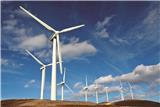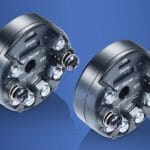The maintenance of yaw control equipment in wind turbine generators (WTGs) continuously challenges manufacturers and operators. When one of the top five turbine manufacturers asked for a ‘quantum leap’ in design to elevate yaw systems, Svendborg Brakes and Stromag answered with an innovative solution. The end result is not only easier to maintain, more durable and reliable, but also features improved performance.
The yaw system is essential to the WTG as it orientates the nacelle towards the wind. However, its frequent operation means that it is prone to wear. This system is one of the leading causes of downtime because the yaw system has a relatively short service life and access is extremely awkward.
In particular, issues often arise in one key yaw system component: the yaw bearing. This works as a rotatable connection between the tower and the nacelle. As such, it is exposed to high loads, originated by the weight of the nacelle and the rotor, as well as bending moments caused by the rotor in operation.
Tackling the challenge
Two main designs are used in wind turbines: roller and sliding bearings:
Roller bearings typically offer smooth rotation and low turning friction. Due to the low friction, the yaw systems have to be equipped with brakes for active braking. This adds complexity to the design and increases purchase and maintenance costs.
Sliding bearings use a low friction material as pads to run along the bearing cage. These pads provide a gliding surface as the gear rim rotates the yaw drive. The higher friction of the gliding bearing provides passive braking. Therefore, while the bearing equipment is simplified compared to roller bearings, the higher level of friction makes wear a greater concern, which can reduce the overall efficiency of the yaw system and cause early failure, also increasing the maintenance costs.
In both roller and sliding bearings, inspections, repairs and replacements require the disassembly of the WTG, further contributing to high maintenance costs. As a result, both arrangements present challenges that compromise their operation and servicing. To develop a new bearing design that is free of these issues, a manufacturer of WTGs contacted Svendborg Brakes and Stromag: partner brands within Altra Renewables and each respected manufacturers of drivetrain equipment for WTGs
Innovative yaw bearing design
Together with its customer, Svendborg Brakes and Stromag discussed how to improve the design of yaw bearings without heavily increasing the cost of the equipment. The ideal bearing system would combine the best of the two existing solutions, while minimising their drawbacks. The two brands combined expertise to design a product that features the efficiency and durability of roller bearings with the simplicity of a sliding bearing.
This has been achieved by substituting the bearing cage of the sliding arrangement with yaw claws. These are clenching structures that circle the yaw drive and regulate its motion. On their surface, the claws incorporate both active and passive braking without needing all the components of the roller design. Each claw is equipped with passive pads to provide passive braking during turning. Once in position, active friction linings will lock the yaw drive by means of active braking and prevent wear of the pads.
By keeping a simple design, with a reduced number of parts, it is possible to minimise the equipment cost and streamline the installation of the equipment. In particular, the yaw bearing system is significantly more economical than existing roller bearings. The hybrid design provides an easy method to replace its components when necessary. With the new solution, it is not necessary to disassemble the entire WGT and downtime is minimised.
Cost-effective solution
The modular nature of the hybrid yaw bearing makes it suitable for new as well as aging WTGs. In the latter case, during maintenance, the turbine operator can decide whether to replace the existing yaw bearing system completely or only part of it. Therefore, they can improve the performance of the WTGs in the most cost-effective manner.
Furthermore, Svendborg Brakes and Stromag have designed in preventative maintenance and remote condition monitoring functions. The hybrid system equips the passive and active brakes with wear detection sensors to allow operators to identify any damages remotely, without the need for onsite inspections.
The innovative solution was developed for key wind turbine manufacturers; nonetheless, it is now available as a non-OEM specific solution for aftermarket installation. The design can be customised in order to withstand specific loads, torques and stresses. The bespoke products are then tested and validated using in-house certified testing facilities.
Yaw bearings are generally WTG’s Achilles’ heel. However, the simple approach adopted by Svendborg Brakes and Stromag when developing the hybrid yaw bearing delivers cost-effectiveness and performance while minimising the complexity of maintenance procedures for operators.
About Svendborg Brakes
Since 1989, Svendborg Brakes has been recognised as a leading global expert in intelligent braking solutions for industrial applications. Extensive application knowledge, innovative design, fast prototyping and exhaustive testing ensure that customers get the most technically advanced, most durable and safest braking systems to meet their specific requirements.
Svendborg Brakes offers a wide range of highly engineered products including hydraulic brakes and power units, thruster brakes, soft braking controls and couplings. Svendborg Brakes braking solutions are hard at work in key markets including renewable energy, mining, hydropower, cranes and oil & gas, mining, and marine & offshore on applications such as wind and tidal turbines, overland conveyors, propulsion systems, deck equipment, hoists, drawworks, elevators & escalators and dam turbines








